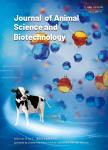Predicting corn digestible and metabolizable energy content from its chemical composition in growing pigs
Predicting corn digestible and metabolizable energy content from its chemical composition in growing pigs作者机构:State Key Laboratory of Animal NutritionMinistry of Agriculture Feed Industry CentreChina Agricultural University
出 版 物:《Journal of Animal Science and Biotechnology》 (畜牧与生物技术杂志(英文版))
年 卷 期:2014年第5卷第3期
页 面:357-364页
核心收录:
学科分类:0710[理学-生物学] 0831[工学-生物医学工程(可授工学、理学、医学学位)] 0832[工学-食品科学与工程(可授工学、农学学位)] 090502[农学-动物营养与饲料科学] 1004[医学-公共卫生与预防医学(可授医学、理学学位)] 0905[农学-畜牧学] 0906[农学-兽医学] 09[农学] 0703[理学-化学] 0836[工学-生物工程]
基 金:financially supported by the National Key Technology R & D Program in the 11th Five Year Plan of China(2006BAD12B01) Special Public Sector Fund in Agriculture(200903006)
主 题:Corn Digestible energy Metabolizable energy Pigs Prediction equation 1
摘 要:Background: The nutrient composition of corn is variable. To prevent unforeseen reductions in growth performance, grading and analytical methods are used to minimize nutrient variability between calculated and analyzed values. This experiment was carried out to define the sources of variation in the energy content of corn and to develop a practical method to accurately estimate the digestible energy (DE) and metabolisable energy (ME) content of individual corn samples for growing pigs. Twenty samples were taken from each of five provinces in China (Jilin, Hebei, Shandong, Liaoning, and Henan) to obtain a range of quality. Results: The DE and ME contents of the 100 corn samples were measured in 3.5.3 ±1.92 kg growing pigs (six pigs per corn sample). Sixty corn samples were used to build the prediction model; the remaining forty samples were used to test the suitability of these models. The chemical composition of each corn sample was determined, and the results were used to establish prediction equations for DE or ME content from chemical characteristics. The mean DE and ME content of the 100 samples were 4,053 and 3,923 kcal/kg (dry matter basis), respectively. The physical characteristics were determined, as well, and the results indicated that the bulk weight and 1,000-kernel weight were not associated with energy content. The DE and ME values could be accurately predicted from chemical characteristics. The best fit equations were as follows: DE, kcal/kg of DM = 1062.68 + (49.72 ×EE) + (0.54 × GE) + (9.1 ] x starch), with R^2 = 0.62, residual standard deviation (RSD) = 48 kcal/kg, and P 〈 0.01; ME, kcal/kg of dry matter basis (DM) = 671.54 + (0.89 ×DE) - (5.57 × NDF) - (191.39 ×ash), with R^2 = 0.87, RSD = 18 kcal/kg, and P〈 0.01. Conclusion: This experiment confirms the large variation in the energy content of corn, describes the factors that influence this variation, and presents equations based on chemical measurements that may be used to predict the DE and ME



